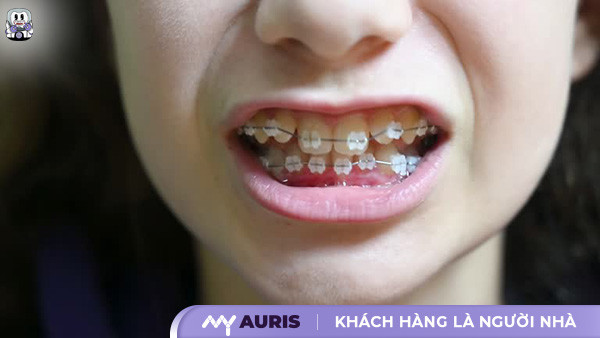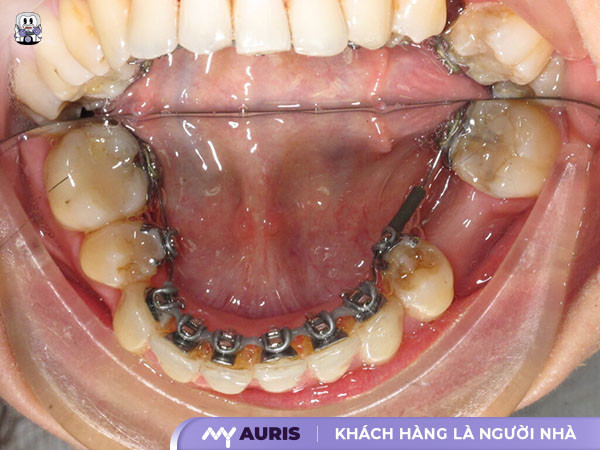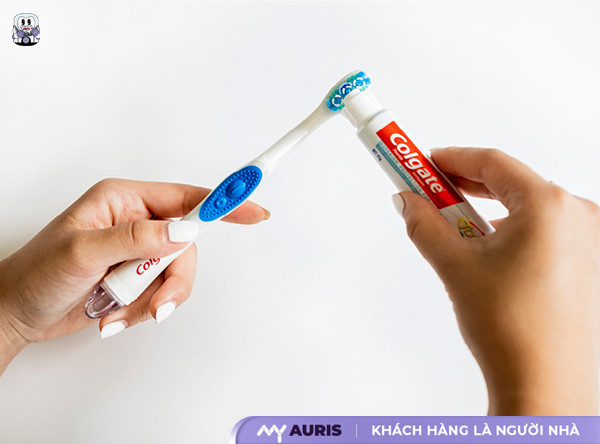A lack of self-confidence due to misaligned, underbite, or overbite teeth is a common concern for many, significantly impacting facial aesthetics. Therefore, orthodontic treatment is increasingly popular for improving this condition. However, a common question arises: is the result of braces permanent? In the article below, My Auris will provide a detailed answer to this question, offering accurate and useful information to our readers.
Is Orthodontic Treatment Permanent?
After wearing braces for 1 to 3 years, you will have a beautiful, aligned set of teeth and a desired smile. However, whether the results of your orthodontic treatment are permanent depends on the retention process after the braces are removed.
Upon completing your orthodontic treatment, you need to continue wearing a retainer to stabilize the position of your teeth. During the first 6 months, retainers must be worn 24/7, only to be removed for eating or proper oral hygiene. After this period, as your teeth become more stable, you can reduce wear to 2–3 hours daily or just at night.
For permanent orthodontic results, you must adhere to the retainer wearing schedule, follow all of your orthodontist’s instructions, ensure post-braces follow-up appointments are kept on time, and maintain a strict post-treatment oral care routine. Your persistence and cooperation are key factors in achieving long-term oral health stability after your braces are removed.

Is Lifelong Retainer Wear Necessary After Braces?
Wearing a retainer is not an option, but a mandatory and crucial stage for stabilizing the results. It is the key to maintaining a proper bite and preserving your smile sustainably over time.
The orthodontic process not only moves the visible part of your teeth. It also affects the entire supporting system underneath.
Memory of gums and periodontal ligaments: Teeth are held in the alveolar bone by a system of periodontal ligaments. During orthodontic treatment, these ligaments are stretched to allow teeth to move to new positions. After braces are removed, these ligament fibers tend to recoil, much like a rubber band, pulling the teeth back to their original positions. Gum tissue also has a similar “memory.” Retainers act as an anchor, holding the teeth in their new positions long enough for these tissues to reconstruct and fully adapt.
Jawbone remodeling process: As teeth move, the surrounding alveolar bone must resorb on one side and rebuild on the other. This process takes time. Immediately after braces are removed, the newly rebuilt bone is still quite immature and not yet strong enough to firmly hold the tooth roots. Without a retainer, forces from chewing, speaking, and bad habits like tongue thrusting can easily cause teeth to shift back.
Daily forces: Your mouth is a constantly active system. Chewing forces, pressure from the lips, cheeks, and tongue always exert force on the teeth. Over time, these forces can cause small shifts. Additionally, the natural aging process also affects bone density and tooth position. Retainers act as a protective barrier, counteracting these forces and minimizing the risk of relapse after orthodontic treatment.
Current Orthodontic Treatment Methods
Metal Braces
Metal braces are the foundational and most popular orthodontic treatment method. They are considered the gold standard for treating complex misaligned teeth due to their strong and stable pulling force. This method uses familiar medical materials such as stainless steel or titanium, ensuring absolute safety for the body.
This method is best suited for cases of severe overbite, underbite, severe crowding, and serious malocclusion. Thanks to their strong pulling force and high control, metal braces can resolve difficult cases where other methods might have limitations. This is also the most economical option, making orthodontic treatment accessible to more people. However, the biggest drawbacks are their low aesthetic appeal and the initial feeling of bulkiness and discomfort. Oral hygiene also requires more patience and meticulousness to prevent dental and gum diseases.

Ceramic Braces
Ceramic braces emerged as an improved solution, addressing the aesthetic concerns of those hesitant about metal braces. Fundamentally, the operating mechanism and treatment effectiveness of ceramic braces are similar to metal braces. The core difference lies in the material. Instead of metal, the brackets are made from high-grade medical ceramic, which is clear or matches the color of natural teeth.
This method is an ideal choice for adults, office workers, and professionals who frequently interact with others but still require effective orthodontic treatment. It provides confidence throughout the treatment period. The biggest advantage is its high aesthetic appeal, allowing you to smile and speak comfortably. However, the cost of ceramic braces is higher than metal braces. Ceramic material also has the disadvantage of being more brittle and prone to breaking with strong impacts. Ceramic brackets can also stain if you frequently consume dark-colored foods and beverages like coffee or tea. The base of ceramic brackets is also slightly thicker than metal brackets, which may cause slight lip protrusion.

Lingual Braces
Lingual braces (also known as invisible braces or braces on the inside of teeth) represent the pinnacle of aesthetics among fixed orthodontic methods. The entire system of brackets and archwires is attached to the inner surface of the teeth, adjacent to the tongue. This means that from the outside, no one can detect that you are undergoing orthodontic treatment.
This method is for those who demand absolute aesthetics, such as public figures, models, actors, or anyone who does not want to reveal their orthodontic appliances. The greatest benefit is its complete invisibility. However, it comes with several significant drawbacks. Cost is the biggest barrier, as this is the most expensive method. Initially, the tongue will feel very encumbered and uncomfortable, potentially even temporarily affecting speech. Oral hygiene is also extremely difficult, requiring persistence and specialized tools.

Invisalign Clear Aligners
Invisalign, or clear aligner therapy, is a revolution in the field of orthodontic treatment. Instead of using brackets and wires, this method utilizes a series of transparent medical-grade plastic aligners, custom-designed for each individual to gradually correct tooth alignment.
Invisalign is particularly suitable for busy adults who prioritize convenience, aesthetics, and flexibility. Ideal candidates include cases of crowding, gaps, and mild to moderate malocclusion. The outstanding advantages are its almost invisible appearance, comfort due to the absence of brackets, and the ability to easily remove them for eating and cleaning. The biggest drawbacks are the high cost and the fact that treatment success heavily depends on patient compliance. If the aligners are not worn for the prescribed number of hours, the orthodontic results will be severely affected. This method may also not be strong enough to handle overly complex malocclusion cases.

How Long Until Teeth are Stable After Braces?
The answer to stability doesn’t lie in a specific timeframe. It lies in your correct understanding and strict adherence to the post-braces retention phase. Tooth stability is a process, not a destination. Below are the stages and factors determining how long it takes for your teeth to truly stabilize.
For teeth to stabilize and not relapse, you need to undergo a clearly structured retention process. This process is divided into specific stages.
Phase 1: Active Stabilization (First 6 to 12 months after debonding)
This is the most critical stage and also the period when teeth are most prone to relapse.
Goal: To firmly hold teeth in their new positions, allowing the alveolar bone and periodontal ligaments enough time to regenerate and adapt.
Retainer wearing time: You need to wear the retention appliance almost all day, approximately 20-22 hours daily. You should only remove it for eating and oral hygiene.
Types of retainers: Your orthodontist will prescribe the appropriate type, which could be a fixed retainer (bonded to the inner surface of the teeth) or a removable retainer (such as clear aligners or a Hawley appliance).
Phase 2: Sustained Retention (From 1 year onwards)
After approximately 1 year, the bone and ligament structures are significantly more stable.
Goal: To continue maintaining the results while allowing the teeth and bone to adapt to normal functional activities.
Retainer wearing time: Your orthodontist may allow you to reduce the wearing time. Typically, this means wearing it only in the evening and while sleeping.
Importance: Although more stable, teeth still risk shifting due to bad habits (tongue thrusting, teeth grinding) or the natural aging process. Wearing your retainer at night is the best way to counteract these forces.
Phase 3: Lifelong Retention (Recommended)
Many leading medical and dental experts recommend considering retainer wear a long-term, even lifelong, commitment.

How to Care for Teeth After Braces to Prevent Relapse?
Retainers, or retention appliances, are essential tools for stabilizing teeth after braces. Your orthodontist will prescribe the type of retainer appropriate for your dental condition. There are two main types: fixed retainers and removable retainers. You must strictly adhere to the usage instructions for each type.
Use a soft-bristled toothbrush and fluoride toothpaste. Brush your teeth at least twice a day for 2 minutes each time. Pay attention to thoroughly brush all tooth surfaces: outer, inner, and chewing surfaces. Special care should be given to areas with fixed retainers.
Use fluoride mouthwash or an antibacterial type as prescribed by your orthodontist to eliminate remaining bacteria and strengthen tooth enamel.
Limit foods high in sugar and acid, as they can damage tooth enamel. Increase calcium- and vitamin-rich foods to help strengthen the alveolar bone, supporting the tooth stabilization process after braces.
Eliminate Bad Habits
- Tongue Thrusting: The habit of resting the tongue against the front teeth when swallowing or at rest can push the front teeth outwards.
- Teeth Grinding (Bruxism): Strong forces generated during teeth grinding can wear down teeth and affect bite stability. If you grind your teeth, discuss it with your orthodontist. They might suggest a night guard.
- Other Habits: Nail-biting, chewing on pens, or using teeth to open hard objects all create unfavorable forces for your dental arches.
Regular Dental Check-ups:
Regular follow-up appointments are an indispensable part of the retention phase.
Purpose of check-ups: Your orthodontist will assess the stability of your teeth, the condition of your retainer, and your overall oral health. They will detect early signs of minor relapse and intervene promptly.
Frequency: Typically, appointments will be scheduled at 1 month, 3 months, 6 months, and 1 year after braces removal. After that, you should continue with annual check-ups.
Proactive communication: If you lose or damage your retainer, or if you feel your teeth are shifting, contact your dental clinic immediately. Do not wait until your next appointment. Early action will help save time, cost, and preserve your treatment results.





